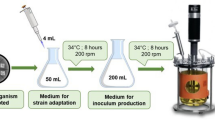Abstract
Coprinus comatus laccase isoenzyme induction and its effect on decolorization were investigated. The C/N ratio, together with aromatic compounds and copper, significantly influenced laccase isoenzyme profile and enzyme activity. This fungus produced six laccase isoenzymes in high-nitrogen low-carbon cultures but much less in low-nitrogen high-carbon (LNHC) cultures. The highest laccase level (3.25 IU/ml), equivalent to a 12.6-fold increase compared with unsupplemented controls (0.257 IU/ml), was recorded after 13 days in LNHC cultures supplemented with 2.0 mM 2-toluidine. Decolorization of twelve synthetic dyes belonging to anthraquinone, azo, and triphenylmethane dyes, by crude laccases with different proportion of isoenzymes produced under selected culture conditions, illustrated that the LacA is the key isoenzyme contributed to dyes decolorization especially in the presence of 1-hydroxybenzotriazol, which was further confirmed by dyes decolorization with purified LacA in the same condition. The crude laccase only was able to decolorize over 90 % of Reactive Brilliant Blue K-3R, Reactive Dark Blue KR, and Malachite Green, and higher decolorization for broader spectrum of synthetic dyes was obtained in presence of redox mediator, suggesting that C. comatus had high potential to decolorize various synthetic dyes as well as the recalcitrant azo dyes.





Similar content being viewed by others
References
Nigam, P., Armour, G., Banat, I. M., Singh, D., & Marchant, R. (2000). Bioresource Technology, 72, 219–226.
McMullan, G., Meehan, C., Conneely, A., Kirby, N., Robinson, T., Nigam, P., Banat, I. M., Marchant, R., & Smyth, W. F. (2001). Applied Microbiology and Biotechnology, 56, 81–87.
Levin, L., Melignani, E., & Ramos, A. M. (2010). Bioresour. Technol., 101, 4554–4563.
Robinson, T., McMullan, G., Marchant, R., & Nigam, P. (2001). Bioresource Technology, 77, 247–255.
Kokol, V., Doliska, A., Eichlerova, I., Baldrian, P., & Nerud, F. (2007). Enzyme Microb. Technol., 40, 1673–1677.
Pointing, S. B. (2001). Applied Microbiology and Biotechnology, 57, 20–33.
Singh Arora, D., & Kumar Sharma, R. (2010). Applied Biochemistry and Biotechnology, 160, 1760–1788.
Campos, R., Kandelbauer, A., Robra, K. H., Cavaco-Paulo, A., & Gubitz, G. M. (2001). Journal of Biotechnology, 89, 131–139.
Couto, S. R., Sanroman, M., & Gubitz, G. M. (2005). Chemosphere, 58, 417–422.
Saşmaz, S., Gedikli, S., Aytar, P., Güngörmedi, G., Cabuk, A., Hür, E., Unal, A., & Kolankaya, N. (2011). Applied Biochemistry and Biotechnology, 163, 346–361.
Yaver, D. S., & Golightly, E. G. (1996). Gene, 181, 95–102.
Mansur, M., Suarez, T., & Gonzalez, A. E. (1998). Applied and Environmental Microbiology, 64, 771–774.
Klonowska, A., Le Petit, J., & Tron, T. (2001). FEMS Microbiology Letters, 200, 25–30.
Lorenzo, M., Moldes, D., & Sanromán, M. A. (2006). Chemosphere, 63, 912–917.
Papinutti, L., Dimitriu, P., & Forchiassin, F. (2008). Bioresource Technology, 99, 419–424.
Lu, X., & Ding, S. (2010). Mycoscience, 51, 68–74.
Bourbonnais, R., Paice, M. G., Reid, I. D., Lanthier, P., & Yaguchi, M. (1995). Applied and Environmental Microbiology, 61, 1876–1880.
Tien, M., & Kirk, T. K. (1988). Methods in Enzymology, 6, 238–249.
Saparrat, M., Balatti, P. A., Martínez, M. J., & Jurado, M. (2010). Fungal Biology, 114, 999–1006.
Dong, J. L., Zhang, Y. W., Zhang, R. H., Huang, W. Z., & Zhang, Y. Z. (2005). Journal of Basic Microbiology, 45, 190–198.
Xiao, Y. Z., Tu, X. M., Wang, J., Zhang, M., Cheng, Q., Zeng, W. Y., & Shi, Y. Y. (2003). Applied Microbiology and Biotechnology, 60, 700–707.
Moldes, D., Lorenzo, M., & Sanroman, M. A. (2004). Biotechnology Letters, 26, 327–330.
Terron, M. C., Gonzalez, T., Carbajo, J. M., Yague, S., Arana-Cuenca, A., Tellez, A., Dobson, A. D. W., & Gonzalez, A. E. (2004). Fungal Genet. O Biologico, 41, 954–962.
Camarero, S., Ibarra, D., Martínez, M. J., & Martínez, A. T. (2005). Applied and Environmental Microbiology, 71, 1775–1784.
Zeng, X., Cai, Y., Liao, X., Zeng, X., Li, W., & Zhang, D. (2011). Journal of Hazardous Materials, 187, 517–525.
Qu, Y., Shi, S., Ma, F., & Yan, B. (2010). Bioresource Technology, 101, 8016–8023.
Eichlerova, I., Homolka, L., & Nerud, F. (2003). Folia Microbiologica, 48, 775–779.
Mechichi, T., Mhiri, N., & Sayadi, S. (2006). Chemosphere, 64, 998–1005.
Susla, M., Novotný, C., & Svobodová, K. (2007). Bioresource Technology, 98, 2109–2115.
Acknowledgments
This work was supported by a research grant (No. 30871987) from the National Natural Science Foundation of China and a Project Funded by the Priority Academic Program Development of Jiangsu Higher Education Institutions.
Author information
Authors and Affiliations
Corresponding author
Rights and permissions
About this article
Cite this article
Jiang, M., Ten, Z. & Ding, S. Decolorization of Synthetic Dyes by Crude and Purified Laccases from Coprinus comatus Grown Under Different Cultures: The Role of Major Isoenzyme in Dyes Decolorization. Appl Biochem Biotechnol 169, 660–672 (2013). https://doi.org/10.1007/s12010-012-0031-z
Received:
Accepted:
Published:
Issue Date:
DOI: https://doi.org/10.1007/s12010-012-0031-z




